- Home
- Bertolt Brecht
Bertolt Brecht: Mutter Courage und ihre Kinder 4 Page 2
Bertolt Brecht: Mutter Courage und ihre Kinder 4 Read online
Page 2
Round Heads and Pointed Heads is certainly long and complex, and it perhaps needs another firm hand, to impose some discipline and to rescue what remains of its political insights. We underestimate the play, however, if we read it just as a botched satire on Nazism. The elements of more abstract and polyvalent political parable remain far more interesting, and indeed frighteningly contemporary. The portrait of a change in government as a betrayal of the people, the gulf between its programme and social reality, the empty promises of populist reformism, the strange mixtures of political conviction and cynicism, political demagogy and its confused echo amongst the people, all strike familiar chords. Embedded in Brecht’s play are interesting commentaries on the relationship between economics and morality, between political representation and substance, and, as in Arturo Ui, between the aspirations implicit in a high-flown verse dialogue, and the sordid reality of men’s deeds. The analysis of racial politics, although it may in retrospect seem inadequate to Nazism, has a great deal of relevance to later twentieth-century conflicts on several continents. The use of racist politics, or even war, as a calculated distraction from social and economic problems is depressingly familiar. And we should not ignore Brecht’s own efforts to generalise his text and, after 1934, to steer it away from explicit reference to Hitler and to Nazism. He was studious in his avoidance of obvious pointers to Nazi anti-Semitism, for example, and the non-specific setting of Yahoo with its Hispanic names and agrarian society can spark off a whole set of associations which have nothing to do with Germany.
The fact that this was one of the very few of his works to be staged at all in the period after 1933 gives Round Heads and Pointed Heads a peculiar prominence in Brecht’s theoretical and practical reflections on acting, ‘Verfremdung’ and the epic theatre. It is often mentioned in the Schriften, simply as the only available example of practice, it features in the Messingkauf Dialogues and again and again in Brecht’s letters. The programme of the Copenhagen première took up Brecht’s essay from the New York Times, ‘The German Drama: pre-Hitler’ (1935, Brecht on Theatre, pp. 77–81), under the new title ‘Episk teater’. As well as its intrinsic literary and political interest, Round Heads and Pointed Heads becomes an important experiment in the development of Brecht’s ideas about the theatre.
The play received its German première in Dresden in 1948. It was revived in several cities in both East and West in the 1960s, but with scant success. Evidently, despite its importance, it was still hard to get the play across. In most other European countries it remains unperformed, or at best briefly mangled by amateurs. On the other hand, the 1990s saw a relative upturn in its fortunes. Manfred Karge directed a widely debated production at the Akademietheater in Vienna in 1993, and in 1998 the Berliner Ensemble staged its first major production of the work. Perhaps its time has now come.
* * *
At the beginning of the 1930s, while both Saint Joan of the Stockyards and Round Heads and Pointed Heads were written for the orthodox theatre, the didactic Lehrstücke, with all their formal originality, were written for left-wing German audiences and professional performers. But by the middle of the decade the political thrust of Brecht’s theatre had begun to alter. Fear and Misery of the Third Reich and the Spanish Civil War play Señora Carrar’s Rifles, both of which were premièred in Paris with the Bulgarian Slatan Dudow as director and Helene Weigel as principal actress, were intended for untrained performers and makeshift theatres; and the same applied also to the two minor satires on Scandinavian neutrality Dansen and How Much Is Your Iron? Themes were contemporary, the scale small, the approach realistic; even empathy was admitted; and only the aleatory, montage-like sequence of scenes was formally new.
These playlets were influenced by the wider scene of Fascism and its European impact, as diagnosed by the Third International, the Moscow-based Comintern. During Brecht’s first year as an exile in Denmark, close to Nazi Germany but cut off from that country’s theatre, publishers and cinema, Moscow’s International Organisation of Revolutionary Theatres (or MORT) was broadened and put under an exiled German director, Erwin Piscator, the Communist who had been Brecht’s major theatrical ally since setting up his Berlin company in 1927. MORT now became part of a whole Comintern arts apparatus, the MORP for writers, the MBRKh for artists, Mezhrabpom, the international workers’ film production organisation, and the International Music Bureau for composers. Hanns Eisler, who had been Brecht’s main musical collaborator since 1930, now became the bureau’s president, and sent his son to the Comintern’s Karl-Liebknecht School in Moscow.
When Piscator invited Brecht to a meeting of progressive theatre directors in that city in spring 1935 he found old and new friends there, not to mention new ideas such as ‘Verfremdung’. Among them were two members of the Comintern Executive who were impressed by the ‘Brecht Evening’ given on 15 May by the VEGAAR or Foreign Workers’ Publishing House. They were Bela Kun and Vilis Knorin, who are thought to have spoken to him about the need for short sketches of Nazi life that could be performed cheaply and independently of any professional stage. Piscator also knew these people, and during the summer of 1935 he developed the idea of producing a whole series of anti-Nazi propaganda films, which could be made separately in different studios. They never materialised, but the idea also appealed to Brecht, who had already started writing poems based on real-life reports from the new Germany – some of them for the anti-Nazi ‘Freedom Radio’. Now he started two years of intermittently writing short scenes that could be strung together and played by political groups opposed to Hitler and his aims. This was the time of the Popular Front movements in France and Spain – the Blum government of spring 1936 and Franco’s rebellion that led to the Spanish Civil War – and it was they that most engaged Brecht on his return from Moscow with a new sense of mission.
But his new toe-hold in Russia was less firm than it had seemed in 1935. With the help of Margarete Steffin, who had been convalescing in the USSR and knew the language, he had renewed his links with Tretiakov, Eisenstein and others of the theatrical avant-garde; his ‘Epic Dramas’ had been published in Russian; Semyon Kirsanov was his translator; he became a lifelong friend of Bernhard Reich and his wife Asya Lacis. But it was not till July 1936 that he got any kind of recognised position, when he became one of the three editors (with Feuchtwanger and Willi Bredel) of a new Moscow literary magazine, published in German by Mikhail Koltsov under his Jurgaz imprint. Called Das Wort, while undoubtedly on the Comintern line, it differed from that body’s magazine Internationale Literatur by the fact that Feuchtwanger and Brecht were both living abroad, while its model was the Neue Deutsche Blätter of Wieland Herzfelde’s Prague-based Malik-Verlag. Brecht was approached about this by Koltsov’s partner Maria Osten, who under her real name of Gresshöner had worked as Herzfelde’s assistant. It did not outlast the fall of Republican Spain, when its last issue included Brecht’s scene of ‘The Jewish wife’. Koltsov returned from Spain (where he is said to have been the model for the journalist Karkov in For Whom the Bell Tolls) only to be arrested, charged with spying for Britain and shot. And Brecht had started talking about what he called ‘the dark times’.
Partly this was because of the new Soviet reaction against the modern movement in the arts, which became crippling early in 1936 with Pravda’s denunciations of Shostakovitch, Eisenstein and other outstanding ‘formalists’, followed by the closing of Meyerhold’s theatre in 1938: denunciations echoed for the German emigration by Georg Lukács’s critical articles, with their schoolmasterly dismissal of reportage, montage and other departures from nineteenth-century naturalism. Partly it was due to the dissolution on security grounds of such internationally staffed organisations as MORT and Mezhrabpom-Film, which led to the abandonment of all Piscator’s plans and to Piscator’s decision to move to Paris. Partly it was due to the wave of arrests consequent on the Great Purge, which began seriously affecting the Moscow Germans and their friends in the second half of 1936.
So whatever stimul
us Brecht had found in the USSR, his hopes of gaining a rewarding new outlet for his work and ideas, and a new platform for the acting talents of his wife, had been knocked on the head. Any chance of a Soviet production of Round Heads and Pointed Heads, or of work on Piscator’s film plans, or of the establishment of a major German émigré theatre in the Ukraine, now disappeared. As for his commission with Eisler for a Lenin Requiem on the twentieth anniversary of the Revolution, it was reputedly handed in in time but was neither published nor performed.
While the Soviet climate was thus changing, the hopes of the European Left were turning towards France and Spain. In France the new Popular Front policy gained an absolute majority in the May 1936 elections, sweeping Léon Blum into power and helping inspire the renaissance of the French cinema; in Spain the Franco revolt against a rather similar Communist-approved government led to the outbreak of the civil war that July. At least for a time it looked as if the task of bodies like MORT would be taken over by organisations based in Paris, and at first this, along with the impending World Exhibition in that city and the mounting movement against war and Fascism, formed the centre of Piscator’s new concerns. Among the Paris theatre groups to be activated as a result was the émigré cabaret called Die Laterne, which was now strengthened by the arrival of Slatan Dudow, the Bulgarian director of Kuhle Wampe and The Mother, whom Brecht had more than once tried to help find permanent work. With Hitler and Mussolini soon giving signs of their intention to intervene in the Spanish war, Dudow wrote to Brecht in Denmark that September to ask for a short play in support of the Republican cause. This now took priority over the Fear and Misery concept, and Brecht instantly started collecting reports and pictures of the fighting, particularly on the northern front. For the moment admittedly he was caught up in the preparations for the Copenhagen première of Round Heads and Pointed Heads, but early in the New Year he got down to the writing, modelling his story on Synge’s Riders to the Sea.
Generals over Bilbao, the new play’s earliest title, became out of date after June 1937 when Franco took that city; so Brecht shifted its locale to the Mediterranean and renamed it Señora Carrar’s Rifles. It was agreed that Helene Weigel would come from Denmark to act with the group, and Brecht also wanted the production coordinated with that of The Threepenny Opera, which Aufricht was once again planning to present in Paris. ‘I imagine it being performed in a very simple style,’ he wrote to Dudow.
Three-dimensional figures against limewashed walls, with the various groupings very carefully composed as in a painting … just calm, considered realism.
It was just this comparatively conventional form of presentation that most satisfied the critic of the local émigré paper Deutsche Volkszeitung and, along with the play’s topicality, allowed it to be taken up by Communist or Popular Front theatre groups in several countries. In addition there was the deep impression made by Weigel’s performance in the title part, which led Brecht to hope that she might be invited to play it in Zurich and other professional German-language theatres. Thanks to this combination of factors, Carrar was a success, and Dudow’s stock went up.
Thus it was Dudow to whom Brecht communicated the start of work on Fear and Misery, even before the Carrar rehearsals had begun. ‘At present,’ he told him in July 1937,
I’m writing a series of little (ten-minute) plays ‘Spiritual Upsurge of the German People Under the Nazi Regime’; these and the Spain play would fill an evening. Minimal cast. As you see, in this way I too am turning to small-scale forms.
In the event the Carrar evening was to be filled out by some Brecht songs performed by Weigel, along with a showing of René Clair’s film Le Dernier Milliardaire. But Brecht saw the new scenes as the best possible way of developing ‘epic’ acting further after his wife’s Carrar performance, and he continued to turn them out during the months that followed. By October the series consisted of five – ‘The spy’, ‘The Jewish wife’, ‘Justice’, ‘Occupational disease’ and ‘The chalk cross’ – under the overall title Angst; in November there were seven; by the following spring nineteen, now to be presented under the Fear and Misery title, with German March-Past as a possible alternative; finally six more by the end of April 1938, when Brecht said that he was stopping at the grand total of twenty-five. By then it was understood that Dudow would stage some of them with a cast including Helene Weigel. Brecht’s main concern at this point was that the actors should not simply be drawn from Die Laterne, whose level seemed to him amateurish, but should if possible include Ernst Busch and Felix Bressart. Dudow’s was rather that the play’s cumulative effect was too depressing, to which Brecht replied that ‘it’s not for us to preach the need to fight back, we show the fight going on. The final “no” seems enough to me.’
As staged in the Salle d’Iéna on 21 May 1938 the play consisted of eight scenes only, presented under the title 99% – an ironic reference to the popular support for Hitler at the elections of March 1936 –and ending (as in our text) with the plebiscite that had followed the annexation of Austria a bare two months before the première. The prologue (‘The German march-past’) and the introductory verses to each scene were set to music by Paul Dessau; this setting, which has apparently not survived, represents Dessau’s first involvement with Brecht. The simple scenery was by Carrar’s designer Heinz Lohmar, this time with costumes by Sylta Busse, who had previously been with one of the German theatre groups in the USSR. Brecht himself received no royalties, nor does the play’s run appear to have exceeded the two performances originally planned. Nevertheless the production was greeted as a success, and not only because of what was generally agreed to be another outstanding performance by Helene Weigel. Thus Walter Benjamin, who at that time was close to Brecht and had a special understanding of his work, wrote in Die Neue Weltbühne that Brecht had turned aside from his experiments in ‘epic theatre’ out of consideration for such émigré groups and their audiences. These needed no specific aids to ‘alienate’ them from the events shown: the alienation was already there, thanks to their political experience, and this made the new balance of the artistic and the political in the new scenes epic indeed. Soaked in current actuality, he said, this unique play would be an enduring testimony for generations to come.
Carrar meanwhile was being widely performed throughout 1938 – not only in Copenhagen (as reflected in our notes pp. 356–62) but also in Stockholm, Prague, New York (by the People’s Theater in April) and San Francisco; likewise by Unity Theatre in London and other British cities. And it continued to be played by similar left-wing groups even after the fall of the Spanish Republic in March 1939, which prompted Brecht to provide the new prologue and epilogue printed on pp. 360–2. The Fear and Misery scenes were not so popular, though Pierre Abraham staged his own translation in various French cities and finally, following the German invasion of Poland, in Paris itself with settings by Frans Masereel. Berthold Viertel too included ‘The spy’ in a mixed programme for the Free German League of Culture in London in May 1939, just when John Lehmann published it in New Writing along with an article on film by Viertel himself. Both Viertel and Abraham however were friends of Brecht’s, and no doubt the problem for other potential directors was that, unlike Carrar, the play as a whole remained unpublished until the middle of the Second World War. Though several scenes appeared in Das Wort (winning somewhat patronising praise from Lukács, to Brecht’s considerable irritation) and elsewhere, the complete work’s expected appearance as part of the collected Malik edition – under the title Germany – an Atrocity Story – was blocked when that edition’s Czech printers were taken over by the Nazis. However, Brecht’s own interest, to judge from his correspondence of the time, lay rather in the possibility of a production in New York, where Eisler had been working since January 1938 and Piscator went at the end of that year. Even before the première Brecht was writing to Piscator to this effect, and from then on he kept the idea in his friend’s mind. There is no sign that he even considered trying for a Soviet production.
>
* * *
The story of Fear and Misery of the Third Reich in America is one of multiple refunctioning and transformation with a view to the major production which never occurred. It begins with the visit of Brecht’s American friend Ferdinand Reyher some five months after the Paris première, when the former, now wholly immersed in that profoundly different play Life of Galileo, met him in Copenhagen. This was just when Brecht had made up his mind to follow Eisler’s and Piscator’s examples and put in for an American visa himself, and as a result he and Reyher now began looking at his recent plays to see how far these could be used to establish him in the US. Galileo was certainly the most important, but the most promising in Reyher’s eyes was Fear and Misery, which he persuaded Brecht to let him adapt with a view to what he termed ‘an honest commercial production’ based on his own skills as a Hollywood rewriter. This meant in the first place tying the original scenes together in a conventional three-act plot. To quote James K. Lyon’s account, Reyher
constructed a frame story involving a young man from the working class named Eric. As the play opens on the night of January 30, 1933, this young worker has been beaten by the SA. He is helped from the scene by the daughter of a Jew, and the two fall in love. They reappear together or individually in a number of scenes. Their relationship has the effect of tying together otherwise unrelated action and events …

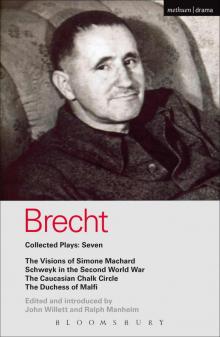 Bertolt Brecht: Mutter Courage und ihre Kinder 7
Bertolt Brecht: Mutter Courage und ihre Kinder 7 Bertolt Brecht
Bertolt Brecht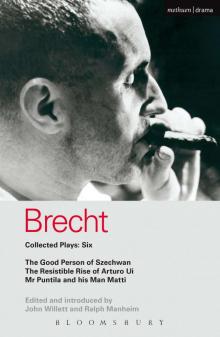 Bertolt Brecht: Mutter Courage und ihre Kinder 6
Bertolt Brecht: Mutter Courage und ihre Kinder 6 Bertolt Brecht: Mutter Courage und ihre Kinder 4
Bertolt Brecht: Mutter Courage und ihre Kinder 4 Bertolt Brecht: Mutter Courage und ihre Kinder 2
Bertolt Brecht: Mutter Courage und ihre Kinder 2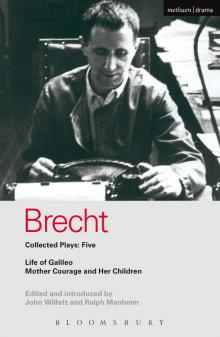 Bertolt Brecht: Mutter Courage und ihre Kinder 5
Bertolt Brecht: Mutter Courage und ihre Kinder 5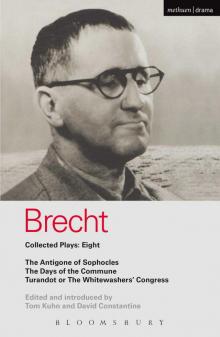 Collected Plays, Volume 4 (Bertolt Brecht: Plays, Poetry & Prose) 8
Collected Plays, Volume 4 (Bertolt Brecht: Plays, Poetry & Prose) 8 Mother Courage and Her Children
Mother Courage and Her Children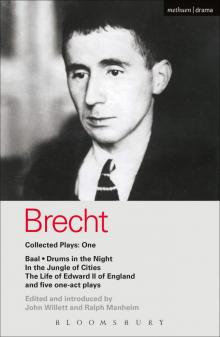 Bertolt Brecht: Mutter Courage und ihre Kinder 1
Bertolt Brecht: Mutter Courage und ihre Kinder 1 Brecht Collected Plays: 3: Lindbergh's Flight; The Baden-Baden Lesson on Consent; He Said Yes/He Said No; The Decision; The Mother; The Exception & the ... St Joan of the Stockyards (World Classics)
Brecht Collected Plays: 3: Lindbergh's Flight; The Baden-Baden Lesson on Consent; He Said Yes/He Said No; The Decision; The Mother; The Exception & the ... St Joan of the Stockyards (World Classics)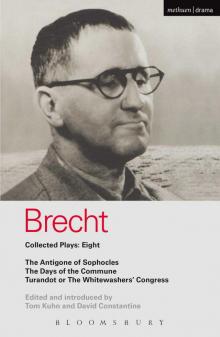 Brecht Plays 8: The Antigone of Sophocles; The Days of the Commune; Turandot or the Whitewasher's Congress: The Antigone of Sophocles , The Days of the Comm (World Classics)
Brecht Plays 8: The Antigone of Sophocles; The Days of the Commune; Turandot or the Whitewasher's Congress: The Antigone of Sophocles , The Days of the Comm (World Classics)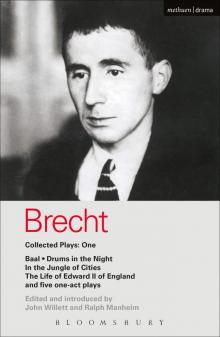 Brecht Collected Plays: 1: Baal; Drums in the Night; In the Jungle of Cities; Life of Edward II of England; & 5 One Act Plays: Baal , Drums in the Night , In the Jungle of Ci (World Classics)
Brecht Collected Plays: 1: Baal; Drums in the Night; In the Jungle of Cities; Life of Edward II of England; & 5 One Act Plays: Baal , Drums in the Night , In the Jungle of Ci (World Classics)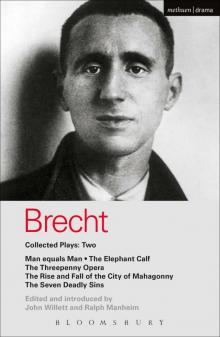 Brecht Collected Plays: 2: Man Equals Man; Elephant Calf; Threepenny Opera; Mahagonny; Seven Deadly Sins: Man Equals Man , Elephant Calf , Threepenny Ope (World Classics)
Brecht Collected Plays: 2: Man Equals Man; Elephant Calf; Threepenny Opera; Mahagonny; Seven Deadly Sins: Man Equals Man , Elephant Calf , Threepenny Ope (World Classics)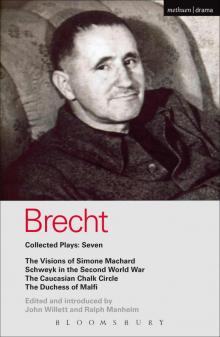 Brecht Collected Plays: 7: Visions of Simone Machard; Schweyk in the Second World War; Caucasian Chalk Circle; Duchess of Malfi (World Classics)
Brecht Collected Plays: 7: Visions of Simone Machard; Schweyk in the Second World War; Caucasian Chalk Circle; Duchess of Malfi (World Classics)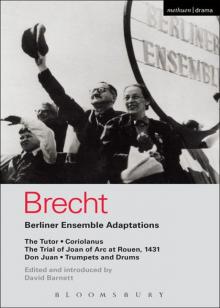 Berliner Ensemble Adaptations
Berliner Ensemble Adaptations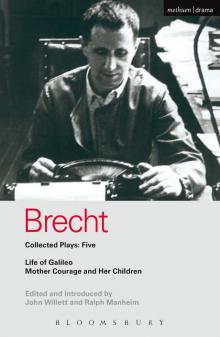 Brecht Collected Plays: 5: Life of Galileo; Mother Courage and Her Children (World Classics)
Brecht Collected Plays: 5: Life of Galileo; Mother Courage and Her Children (World Classics)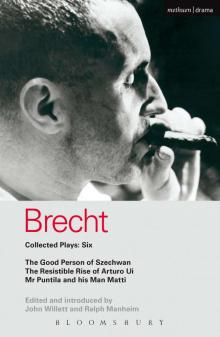 Brecht Collected Plays: 6: Good Person of Szechwan; The Resistible Rise of Arturo Ui; Mr Puntila and his Man Matti (World Classics)
Brecht Collected Plays: 6: Good Person of Szechwan; The Resistible Rise of Arturo Ui; Mr Puntila and his Man Matti (World Classics)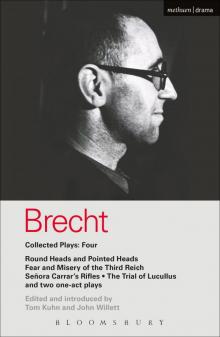 Brecht Collected Plays: 4: Round Heads & Pointed Heads; Fear & Misery of the Third Reich; Senora Carrar's Rifles; Trial of Lucullus; Dansen; How Much Is ... and Misery , Carr (World Classics)
Brecht Collected Plays: 4: Round Heads & Pointed Heads; Fear & Misery of the Third Reich; Senora Carrar's Rifles; Trial of Lucullus; Dansen; How Much Is ... and Misery , Carr (World Classics)